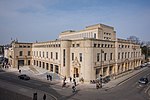History of Science Museum, Oxford
1924 establishments in EnglandBuildings and structures completed in 1683Grade I listed buildings in OxfordGrade I listed museum buildingsHistory of museums ... and 6 more
History of science museumsMuseums established in 1924Museums of the University of OxfordScience and technology in OxfordshireScience museums in EnglandUse British English from August 2015

The History of Science Museum in Broad Street, Oxford, England, holds a leading collection of scientific instruments from Middle Ages to the 19th century. The museum building is also known as the Old Ashmolean Building to distinguish it from the newer Ashmolean Museum building completed in 1894. The museum was built in 1683, and it is the world's oldest surviving purpose-built museum.
Excerpt from the Wikipedia article History of Science Museum, Oxford (License: CC BY-SA 3.0, Authors, Images).History of Science Museum, Oxford
Radcliffe Square, Oxford City Centre
Geographical coordinates (GPS) Address Nearby Places Show on map
Geographical coordinates (GPS)
| Latitude | Longitude |
|---|---|
| N 51.75443 ° | E -1.25519 ° |
Address
Radcliffe Square
OX1 4AJ Oxford, City Centre
England, United Kingdom
Open on Google Maps








